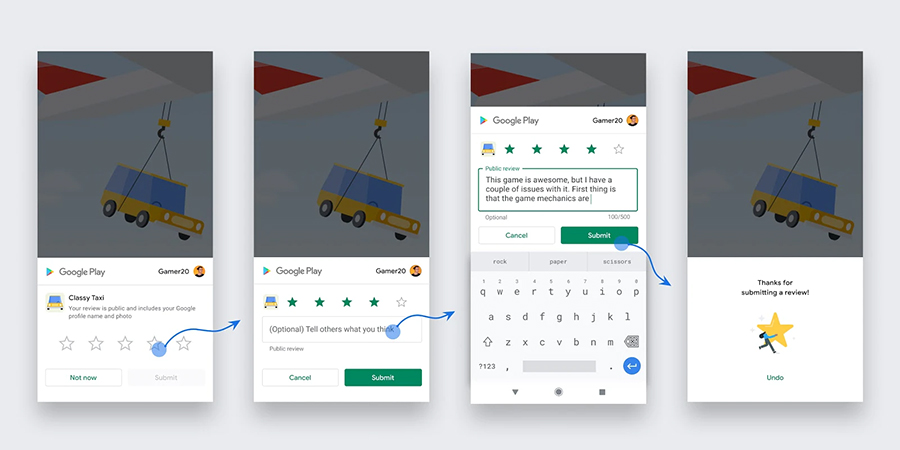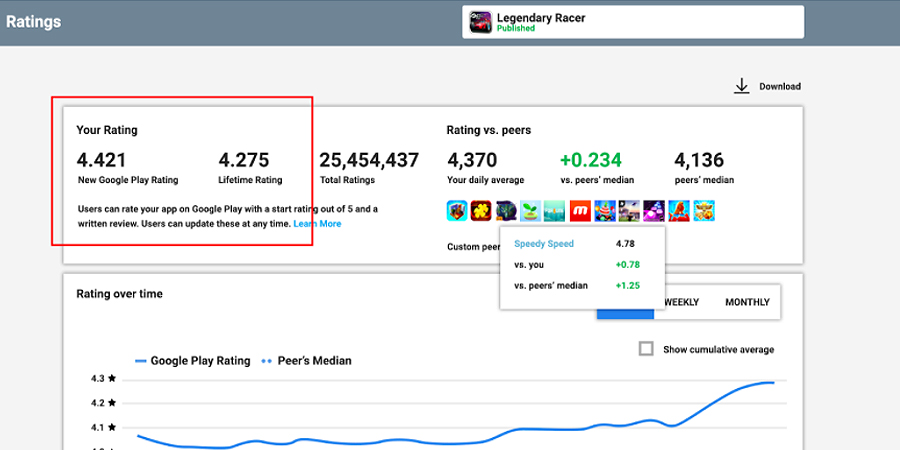Oct 19, 2020 App Development
Google Play In-app Ratings and Reviews API Changes: New Changes Revealed
Oct 19, 2020 App Development

Oct 19, 2020 App Development / Neha Joshi
Over the years, we have seen that app reviews are crucial for the success of any mobile app. It’s not just important to convince other people to download and use your application. It’s also important for the algorithms and your rankings and everything like that. The more reviews you have and the more ratings you have, the better it gives more proof to Google Play that your app is being used and people like it.
Now, historically it’s been not easy to get reviews. You have an app, you can understand that it is pretty difficult and sometimes you have to plead for the review. Like every time you would update an app, you may have asked your users, please leave a review. You’d have the annoying pop-ups that would come up saying, “Please leave a review,” and then you have like a button that’s prominently placed to say, “Please leave a review.”
Now, usually, when you’d have that there, they would click on a button, and you would take them back to the play store or the app store because that was the only way to leave a review. Back in the old days, it was very difficult to actually do it within the application. Then, a few years ago in iOS 10, the app store did start allowing that so you could have these prompts within the application where they can leave a rating from within your application and you don’t have to leave your application and go someplace else.
At the beginning of August, Google Play announced that they have a service that does the same thing. Now we have the Google Play in-app review API which allows you to do a very similar thing. It will have the little pop-up that comes up and people leave a five-star review and then they could just submit it. So, it is really easy to start building up those numbers and getting those reviews coming in because like I said it’s really important.
In this article by Google, you can see the device requirements and when to request an in-app review. Now here’s a few things that are really important to point out because I’ve seen this a lot in the past where people say do you like the app and if they say yes then you send them to get a review and if they say no then you’re like okay well thanks for letting us know. So you only send the people who like the app to leave a review.
Well, here it says you could trigger an in-app review flow after the user experienced enough of your mobile app or game in order to provide useful feedback to the developer. But here it says do not prop the user excessively for review. In addition, this recent approach helps minimize the frustration limit. Also, your mobile app should not ask any user questions before or while presenting a rating button or card including questions about their opinion such as do you like the app or predictive questions such as would you rather rate the app five stars.
With the new update, mobile app publishers can now prompt their users for reviews and ratings without making them bequeath the mobile app. Therefore, in order to keep users in their intended experience, you need to avoid interruptive & frustrating user experience, which helps in improving the overall user experience with your mobile app.
It is often said that these kinds of rating prompts are kind of disruptive mechanisms. This prompts focus away from your users’ intended use of the mobile app. Although, in this cutthroat competition, reviews and ratings are pretty crucial to long-term mobile app success.

Google Play changed its rating and review algorithm at the end of August 2019, and it also continues to change as seen in their recent 2020 update. In addition, the average rating calculation for the mobile apps will be updated for all Android based apps published on Google Play. Also, in spite of a lifetime cumulative value, Android mobile applications’ average ratings are recalculated to give even more weight to their recent ratings and reviews already. But with the recent update, the weight of “newness” matters a lot.
Just like the changes done in the year 2019, this new update will also allow users to see a more precise state of the mobile app. It includes bug fixes and various other new features for offering a better experience to the users. We have seen that experience over the years is not the main factor in evaluating the rating of an app. Although, the latest change means that optimum quality mobile apps that have not released updates recently will now have a proper rating that reflects a current state of decline.

So, for those guys who are thinking about doing it only getting people to rate the application. If they really like it, you can’t do that at least it’s against the terms. You might be able to get away with it.
Now if it’s available on Android so now you have the Android side and the iOS side. If you’re a flutter developer you know already these plugins are showing up where you can have the in-app review API. On flutter, you could do either the Google play side or the iOS way and have everything go in there.
I hope this new update brings many positive changes in putting reviews and ratings. Being a business owner, you have to create an app that follows all the guidelines of this new change otherwise your app may get penalized by Google. You need to find the best mobile app development company in India having expertise in creating such an app by following all the guidelines of Google.